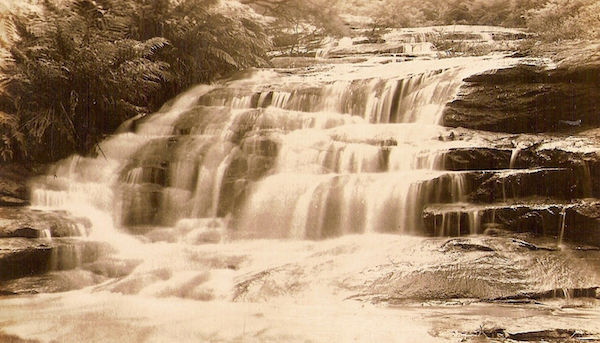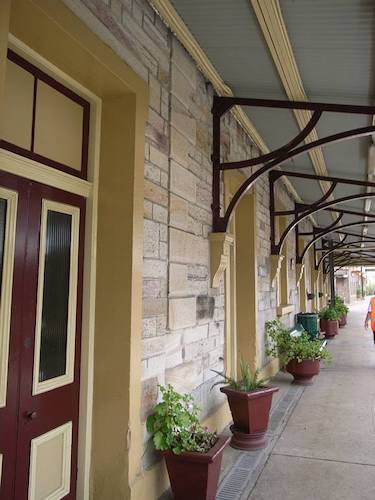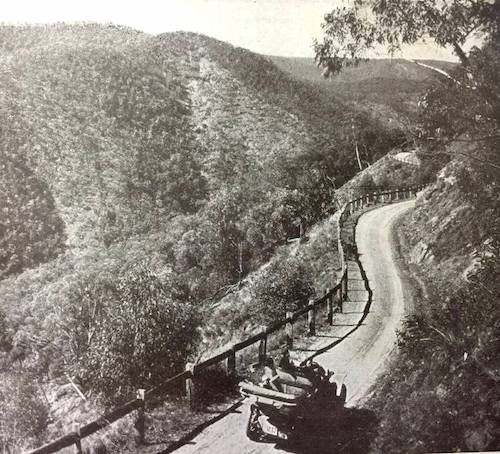I’m an old woman now, and live by the sea, but I remember the Blue Mountains. I knew them well and drank from the clear streams in my youth.
To recall my first experience of these mountains I must step back to the early 1920s and see myself as a little child, tired, cranky, enduring the train journey from Orange to Sydney. I was frightened of the tunnels, the noise and the smoke streaming past the window in ghostly wraiths. Father made a heavy mark with chalk on the lid of his kitbag for every tunnel. “Here comes another one” he would say as the noise increased and my baby sister opened her mouth to roar. At Mount Victoria he would alight to buy some food and perhaps pick up a handful of snow to show us. We would be in a panic that the train would start without him.
I remember a little of the first holiday we spent in Blackheath, in a cottage overlooking Megalong Valley, and to my eyes it appeared to be up in the sky. There were steps cut into the earth bank from the gravel road right up to the wide verandah of the house. Little flowers grew in the steps, little warm coloured stones were just asking to be collected. Strange that I recall those steps! And the stones! I liked them more than the Three Sisters.
Yes! We visited the Three Sisters. The Lookout then was fenced with wire. We all yelled “Cooee” and heard the echo return. Imagine that today! My father pointed out the Sisters and I had no idea what he was talking about as I looked vainly for them below among the tiny far-off trees.
We also visited Jenolan Caves. A long open limousine drew up on the road below the cottage but I just wanted to stay and play with the stones on the steps until my mother hustled me down. What did I know about caves or the long journey ahead? The other tourists smiled as I was tucked into the dicky seat, well wrapped for the windy drive. The wonder I felt in the caves that day remains with me in old age.
Dad was a clergyman in Redfern during the worst years of the Depression. In January of 1932 we went for a holiday to Blackheath in the very house in Shipley Road. Still there – the steep steps, the latticed verandah, the view of Megalong, the old watertank and fuel stove. There was a tin bath in a draughty lean-to but the water had to be heated in a kerosene tin on the stove. There was no shower and the old dunny was in the backyard overlooking the valley. All I remembered was the steps, but the magic was there.
From our vantage point at the head of the Megalong it was easy to go down to the blue depths. Sometimes before breakfast Dad would pack the old black billy with mugs, tea, sugar and milk, all wrapped in newspaper to start a campfire, and we would take a loaf of stale bread with butter, jam and knife, then pile into our little Morris Minor and drive to Mermaid’s Cave. We would leave the car at the top sign and descend a narrow cleft into a hidden place where a waterfall spilled into the green light of an open cave full of ferns, tumbled rocks and white ledges. There was a picnic table by a pool, and a fireplace where we would light a fire, boil the billy and toast the bread over the embers, precariously speared on a green forked stick. If the bread fell off, what did it matter? Spread liberally with butter and jam there is nothing that tastes or smells so good this side of Heaven!

Sometimes we would go farther down the valley for our breakfast and always get our water from the creek. In those days we could drink from any mountain stream. How wonderful it was!
After a few holidays we knew most of the sights and walks and ventured farther afield. There were exciting things to see in Katoomba and Leura in the 1930s. The floodlighting of Leura Cascades had just been completed.
Then we heard about the railway truck which ran down the cliff to the coalmine near Katoomba Falls and it was possible to thumb a ride if one was brave. We were brave enough for anything! So we fronted up at the top of the little railway and when the next empty truck went down Mum and Dad were sitting on sacks in it and Flo and I were standing on the wooden bumper at the back, hanging on for grim death. The guard stood on the side bumper and warned us: “When I tell you to crouch, DO WHAT I SAY!”
Modern riders of the Scenic Railway know how deceptively gentle is the first slope, then the line plunges through a tunnel so steeply downhill that the carriages seem to be suspended. When the sudden drop happened and the roof of the tunnel threatened to knock our heads off, we were petrified and could hardly obey the man as he yelled at us. We’re still here to tell the tale! Now when I see the Scenic Railway at Katoomba and hear the long scream from a hundred throats as the modern carriages loaded with tourists go down – I REMEMBER!
I wonder now, as I write this, how many of my tribe are left? Folk who walked the Blue Mountain tracks in the 1930s, who saw the beginning of things and could drink from any mountain stream?
© Grace Bayley, August 2002
This article was published in July 2003 Hut News, the newsletter of Blue Mountains Conservation Society. Grace Bayley was a former newsletter editor of the Society. Grace and her husband left the mountains in late 1995 to live in Gerringong on the South Coast of NSW. With the encouragement of Jim Smith, Grace published a book, “Take it Slowly, a Blue Mountains diary”, in 1993. Grace Bayley died peacefully in Gerringong on April 26, 2014 at the age of 93.



